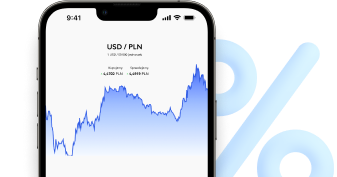Exchange rate USD - US dollar
U.S. dollar (the United States dollar) - the official currency of the United States, Puerto Rico, Micronesia, Northern Mariana Islands, Palau, the Marshall Islands, Panama, Ecuador, El Salvador, East Timor, Zimbabwe and Bonaire, Saba and St. Eustatius. One U.S. dollar is divided into one hundred cents U.S.
Select currencies and check rates
Live rates.
Update: 30s
| Currency | Buy | Sell | Name | Currency code |
|---|---|---|---|---|
| USD PLN | 3.8323 | 3.8930 | US dollar | 1 USD |
US dollar exchange rate - chart
Last currency comments
Over 900 000 reviews
Customers rate us 4.9/5.0.*
Start saving today
Forget about unfavourable rates and hidden fees. See how much you can save. Create a free account and start converting currency online.
Open account for freeThe U.S. dollar
The U.S. dollar (USD) is one of the world' most popular currencies. The USD is the one most often compared to other currencies to determine their value, or current exchange rate. The U.S. currency is generally associated with green banknotes, although many denominations also contain many black elements. They are made not from cellulose, but a mixture of cotton, linen and several other raw materials.
The U.S. dollar - where is it used?
The U.S. dollar is the official currency of the United States, but not only there. Greenbacks (a common name for the currency) are also recommended when travelling to Micronesia, Puerto Rico, El Salvador, Palau, Ecuador, East Timor, Zimbabwe, the Marshall Islands, the Northern Mariana Islands or Bonaire, Sint Eustatius and Saba. In those places, the dollar is also the official currency. Since the U.S. dollar is globally recognized and widely used, you can pay with it even in places where it is not the official currency. This includes large tourist resorts, where local vendors willingly accept dollars. However, before the trip, it is worth checking the dollar exchange rate and converting the currency in an exchange office to avoid unfavourable rates on the spot. To quickly calculate the dollar's current exchange rate (e.g. USD to EUR, or EUR to USD), you can use the currency converter available on our portal.
History of the U.S. dollar
The American dollar was named after the word thaler, which was spread across Europe in the 16th century. This term was used for silver coins minted in the Czech Republic and those produced in Spanish colonies. Eventually, they reached North America, where they began to be called Spanish dollars. These coins were so abundant in circulation that after America gained independence, the United States decided to adopt them as the official payment method, displacing the British pound. For a long time, the U.S. dollar was exchangeable for precious metals - initially for silver, later also for gold. However, in 1933, President Franklin Delano Roosevelt issued an executive order that prohibited American citizens from owning gold. They were obliged to exchange it for dollars. A year later, the price of gold was artificially raised, devaluing the USD against gold by about 40%. The ban on owning gold was lifted in 1974, but by then the rule of dollar convertibility to gold was no longer in force.
More about the U.S. dollar
The U.S. dollar is divided into 100 cents. There are coins in circulation with denominations of 1, 5, 10, 25 and 50 cents. The reverse displays silhouettes of the founding fathers and presidents of the United States. The obverses show various commemorative images, the Monticello estate, and the President of the United States' seal. The banknotes are available in denominations of 1, 2, 5, 10, 20, 50 and 100 USD. Here too, the obverse shows the presidents and founders of the United States. The obverses depict, among other things, the most important architectural buildings of the United States. Over the years, the design of U.S. dollar banknotes has changed considerably. Many of them, especially the older ones, are no longer in circulation and possessing them is a collector's asset. However, it is worth remembering that formally each of the issued banknotes is still an official means of payment and can be used to pay, for example, in stores.
What influences the USD exchange rate?
The current USD exchange rate depends on many complex factors, therefore forecasting it is extremely difficult. The dollar is one of the four main currencies in the world. Its price is influenced by major economic and political events in the world. Currency quotations also depend on the price of gold and oil. The value of these commodities is expressed in U.S. dollars. The USD exchange rate may also be influenced by such phenomena as inflation, the level of interest rates or current U.S. politics. The wide range of factors affecting the dollar exchange rate makes accurate forecasting remarkably complicated, and predicting changes in the USD/EUR currency pair, for example, is difficult even for professionals.






























